Introduction to Noel
Calleja's case study
by Antoinette Camilleri Grima
|
Noel Calleja is head
teacher of Mgarr Primary School, Mgarr, Malta..\Workshop\Calleja
ppp.ppt. In this case study he focuses on
the role of the Head teacher in the implementation
of innovation in language education. Head
teachers, although they are almost always ex-teachers
and have plenty of teaching experience at the
chalk face, and sometimes also in academic research,
they do not necessarily have a background in language |
education as many of them might be coming
from other curricular areas such as mathematics, history,
the sciences and so on. Nonetheless, as Calleja illustrates,
they have a key role to play as instruments of change.
Head teachers need to have a vision - of where they
are leading the school - based on a deep understanding
of the issues involved - such as those explained in
the Guide. It makes sense, therefore, to pay
attention to the proposal exemplified in this case
study where a kind of 'policy for policy-making',
based on action research, and involving several partners
such as teachers, parents, and experts, is presented
as a realistic way of successfully implementing change
with a view to plurilingualism and plurilingual education
(ACG_introduction.ppt)
.
The sociolinguistic and educational context of Maltese
schools is different from the others described in
this publication because Malta has been a bilingual
country for several decades. In fact, Maltese
and English have co-existed in a bilingual system
of education from early primary school onwards.
Yet, Noel Calleja shows that the head teacher will
always have a key role to play in providing a vision
for development in language education. The head
teacher is like a master conductor who needs to keep
all the different musicians playing together in tune
and harmony. |
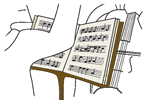 The
Role of the Head teacher in the Implementation of Plurilingual
Education The
Role of the Head teacher in the Implementation of Plurilingual
Education
Noel Calleja
Introduction
One must recognise the efforts of the ECML and the Language
Policy Division of the Council of Europe to promote plurilingualism
among its member states. All this is happening when Europe
is going through many social and political changes. The
Council of Europe has described this societal context in
detail, and has expressed its vision in the Guide (p. 109):
"The aim of the Guide is to provide a reference
for the shaping of policies for language education and
therefore for establishing goals and identifying the technical
means of implementing them."
My aim is to describe how we have proceeded to establish
goals for school development in the area of language education,
and to link the process in a critical way to the Guide -
not to argue for or against what is said in the Guide, but
to promote a school-based action research approach as a
realistic and grounded way towards change and innovation.
At the out stead, I would like to make it clear that there
is a strong emphasis on bilingualism in this context because
of the reality of the Maltese situation and not in contradiction
with what is being advocated in the Guide. In fact, the
long existing tradition of bilingual education in Malta
must be viewed as a stepping stone towards the other goals
of plurilingual education.
As head of school, I would also like to represent and explain
the key role of the Head in any school improvement plan,
highlighting his/her qualities for the success of an approach
favouring innovation. The workshop for Head teachers held
in Graz in December 2005 was a concrete recognition of this
fact. Formal and informal meetings there, created the right
atmosphere for future international collaboration. This
happened because a number of people holding key positions
in schools, came together for a number of days of intensive
and focused work.
In the following description I make reference to the theoretical
principles behind school- based action research leading
to school development planning, with particular reference
to the role of the Head of School. At the same time I illustrate
how this approach was successfully adopted at Mgarr Primary
School in Malta.
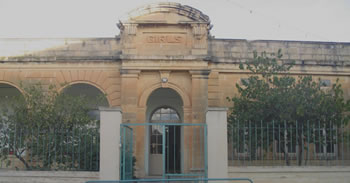 |
Mgarr Primary School is a co-educational
school
for children aged 3 to 11. |
|
Heads of School and School Improvement
- Identifying Needs
Heads are considered to be in an advantageous position
from which they know what is going on in their school. They
are in a better position to identify needs for improvement
because of greater contact with outside agencies at the
same time. School Heads are expected to be the managers
of improvement, creating in their schools the right atmosphere
for it to happen. They need to have a clear sense of direction
for their schools and, in collaboration with their staff,
discuss and draw up plans of how to get there. Action research
is one way of implementing school-based development in order
for improvement to take place in an effective way. Without
dynamic leadership on the part of the Heads, who develop
a clear vision for their schools and who communicate it
well to their staff in such a way as to mobilise all members
so that they all take part in school-based development,
effective improvement in schools cannot occur.
As soon as I became head teacher of Mgarr primary school
in 2002, I immediately felt the need to look at the way
language education was being carried out there. The Maltese
National Curriculum (Ministry of Education, 1999) recommends
a language policy which highlights the need to develop every
learner's bilingual competence, but I understand that linguistic
policies have to be integrated in everyday life at school,
and should underlie school development planning (Lakesandrivers_results).
The Maltese sociolinguistic context is one where (i) Maltese
and English are official languages, and Maltese is defined
as the national language, and (ii) bilingualism in Maltese
and English is considered as the basis of the Maltese educational
system. Principle 10 of our National Minimum Curriculum
(NMC) (Ministry of Education, 1999) highlights this point
and, in conclusion, states that it is the task of each school
to develop a linguistic strategy which reflects the particular
needs of its students. And that:
"In so doing, it should not overlook the fact
that Maltese society has its own native language and recognizes
English as an official language that has also developed
into an international lingua franca. Equal importance
should be given to the teaching of the first and second
languages at all levels." ( p.38)
The teaching of both Maltese and English at primary level
has long been an integral part of Maltese Education. Let
us not forget that before independence in 1964, Malta had
been a British Colony for almost two-hundred years and,
that during this time, social ties developed while there
was a political relationship evolving. This helps one understand
that efforts to teach the two languages effectively have
always been made. And so, one might ask, "What is new
here and now?"
As head teacher I was inspired by the sociolinguistic reality
described above, and by an understanding of the reference
from the NMC, as well as by the following, complementary
quote from the introductory note to chapter 6 of the Guide:
"If the cultural and political conditions are established,
it will be possible to organise language education on the
basis of plurilingualism. It will not, however, be implemented
in exactly the same way everywhere since the aim is not
to produce citizens with identical linguistic repertoires
throughout Europe, but to enhance the status of and extend
repertoires according to local situations in the framework
of a shared plurilingual education." (p.77)
I decided to move with a view to improved bilingual education
provision first, and then to slowly proceed to a diversification
of language provision. The linguistic, cognitive and social
advantages of bilingual competence are uncontested. The
international research literature is replete with examples
of different forms of bilingualism and bilingual education,
all of which are conducive to successful language learning
and language education.
Head teachers as Educational Leaders
with a Vision
School improvement, followed by planned changes in school
policies and practices, is not possible without a clear
vision for the future. Vision is central to any school based
development. However, tensions may arise when a head of
school has a clear vision for the school's future which
may not in the first instance be shared by the staff members
(Lashway, 1997). This is where the Head teacher has to have
other skills such as the ability to take the lead and actively
push things forward because he/she remains the chief instigator,
promoter and guardian of that vision. Lashway (1997) ends
his paper by highlighting an important strategy to be adopted
by leaders with a vision, that of facilitating change/improvement:
"Above all, principals must create a climate and a
culture for change. They do this by speaking about the vision
often and enthusiastically; by encouraging experiments;
by celebrating successes and forgiving failures and by remaining
steadfast in the face of the inevitable problems and missteps."
(p.3)
Thus, the first step I took in 2004 was to discuss my plan
with an expert from the University of Malta, Dr Antoinette
Camilleri Grima, and to organise a staff development seminar
to introduce the idea of action research with a view to
improved language provision to the teachers. During this
seminar teachers listened to a presentation by the expert
about the aims of bilingual education, and of action research,
and then had plenty of opportunity to voice their opinions
and give an oral assessment of the language situation. The
first stage of the action research plan was to take stock
of existing policies and practices (a fact-gathering stage)
because each school is unique in its linguistic make-up.
Thus, each school needs a language and learning policy that
takes into account the specific characteristics that help
or hinder the development of language education within its
given context (School profile).
As part of the stock-taking exercise, which lasted from
October 2004 until March 2005, the school embarked on a
number of initiatives in order to establish facts about:
- Home language background of staff and pupils
- Teacher education experiences (training, philosophies,
etc)
- Explicit policies in existence (national policy for
state schools; any other more localized and specific school
policy)
- Actual day to day practices (who speaks/writes which
language to whom, when, why)
The sources of evidence for the above included:
- Existing documentation (previous school policies and
plans, language history within the school, children's
writing, circulars, etc.)
- Interviews (by the expert with the Head, the Assistant
Head, Teachers, other staff)
- Classroom observation (by the expert during January-February
2005)
- Participant observation (diaries kept by Head about
which language is used when and for what purpose, e.g.
morning assembly, to communicate with teachers, with parents,
with other persons present on the school site; and by
teachers who were asked to reflect about, and verbalise
their own philosophy of bilingual education, and to become
aware of how they use the two languages at home and at
school)
- A record of language use in writing (e.g. charts, notice-boards,
signs, art-work with titles and other information)
A questionnaire to assess the use of the two languages,
inside and outside school, by pupils, teachers and administrative
staff was produced. The results gave us a clear picture
of the linguistic reality at Mgarr. The main outcomes confirmed
Maltese as being the home language of both pupils and teachers
while both languages are used, at different times and in
different ways, at school.
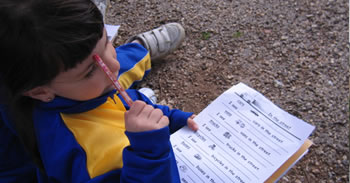 |
A five year-old pupil filling in
a handout in English
on the topic 'transport'. |
|
Facilitative Leadership -
Collaboration and Empowerment
A shared vision brings people together to discuss and draw
up school development plans, to improve upon existing school
policies and practices. The second phase of our action research,
now that we were all concentrating on the data we had gathered,
was to organise a phase of reflection and decision-taking
for the implementation of revised policies.
From my point of view as head teacher, I kept in mind that
the modern style of management is that of collaboration
and empowerment, and not as it was up to a few years ago,
rather hierarchical and based on authority. Lashway's Facilitative
Leadership (1995) and Strategies of a Leader (1996) both
deal with the shift of emphasis from authoritative to facilitative
leadership. He quotes Dunlap and Goldman (Lashway 1995)
who say that, "In short, facilitative power is power
through, not power over". (p. 2)
At another staff seminar in the Spring of 2005 the results
of the fact-finding phase were shared. This was seen as
an opportunity for the head to disseminate, among the teaching
staff, the principles underlying the National Minimum Curriculum
as well as the Head's own vision. It was done through an
internal debate and culminated in the re-formulation of
the School Development Plan for the next school year.
The outcome of the second seminar was a plan of action
in which everyone in the school had a role to play. The
priority targets, in this area, as expressed in the School
Development Plan were:
- To increase the learner's exposure to the English language.
- To use more educational videos and books in English
with structured follow-up activities.
- Drama activities to boost pupils' self confidence in
using English.
The action that followed included initiatives such as
the following:
- The Head together with the expert wrote an application
for a Comenius Language Assistant. The aim of having a
Language Assistant was to provide pupils with an opportunity
for interacting with a native English speaking teacher
- given that most of the pupils in this school lacked
this kind of experience. (the Guide on p. 81, for example,
lists some possibilities for introducing specialised teachers).
- The teachers offered to attend a two-week staff development
programme specially organised for them after school hours.
An application for funding was made, and accepted by the
National Curriculum Board, so that special training could
be offered on the writing-process (the Guide on p. 82,
for example, specifies the need to develop language courses
"concerning languages approached in a diversified
way, that satisfy the expectations of regional communities
and national requirements").
- The drama teacher agreed to use English only in his
interaction with the children. (The Guide, in section
6.4, talks about decompartmentalising language education
and diversifying provision).
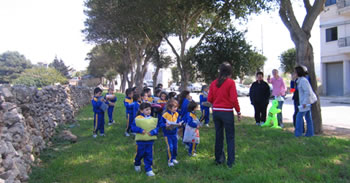 |
Parents help the class teacher during
an
outdoor activity. |
|
The most satisfying aspect of what was going on was that
everyone felt that they owned this project. The collaboration
of every teacher was amazing and their enthusiasm was infectious.
One of the reasons for this was that they themselves had
identified the issues, and had made suggestions for improvement
based on their knowledge of the context and of children's
needs (School policy). It
is interesting to note that members of the Parents Council
also became motivated to help when they witnessed the way
the school was working. One parent approached the local
council and asked for financial support for books for the
local library, and the President of the Parents' School
Council, who owns a local restaurant, organised an informal
meeting with an English couple resident in the village who
offered their time to the children. (The Guide in section
6.5 talks about structuring diversified educational paths,
which in our case started with an experiment, inviting English
residents into the school).
The implementation phase will continue during the coming
school year, October 2006 to June 2007, when the intensive
and focused staff development programme will also take place.
Evaluating change - a loop of re-organisation
It is also envisaged that during the school year 2006-2007
an evaluation activity will take place. The Guide (section
6.2.1, p. 78) recommends a periodic review of the language
education which is provided in terms of what is known of
user expectations. We are aware that we need to continually
take stock of the changes implemented and to review our
policies and practices. We know that we have been successful
in some areas, less successful in others, and that we have
reaped some fruit which came as a side effect of our project.
For example, as a 'side effect' of the plan, there has been
an increase in the use of the reading room, and a small
project which included e-mail correspondence with an English
school. Furthermore, as a direct result of the December
2005 workshop in Graz, initial exchanges with a Spanish
and a Romanian school took place and it is planned that
all our European contacts will be consolidated in the year
2006-2007 (Network
x4, Maltese team, resource
1 Malta).
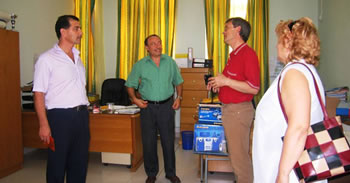 |
| This photograph documents a visit
by Wolfgang Pojer, an ENSEMBLE workshop participant,
to Mgarr Primary School in November 2006. From
Left to Right: Noel Calleja, Head of Mgarr Primary;
Alessio Saliba, the Assistant Head; Wolfgang Pojer,
Head of Sprachen-Hauptschule Birkfeld in Austria;
Mrs Pojer. |
|
Conclusion
Finally, I would like to clarify a distinction between
organisational philosophy and culture. Whereas, to my mind,
philosophy refers to the Heads' personal beliefs, culture
refers to those underlying the behaviour of the organisation.
Therefore, the beliefs of the Heads guide their managerial
behaviour, while the organisational culture affects the
behaviour of everyone within the school. Managerial style
is the chosen manner that determines the behaviour of the
Heads within the constraints placed by the organisational
culture and guided by their personal philosophy. There can
be no doubt that Head teachers need to familiarise themselves
with the Guide, and similar documents produced by the Council
of Europe, as well as with the numerous projects of the
ECML so that they can be in a better position to develop
a language education vision for their school. I have tried
to show that the head teacher has a crucial role to play
in instigating change, and implementing innovation in school.
In order to do this he/she must have the right philosophical
baggage which comes from reading the relevant documents
and more effectively by being involved in projects like
the ENSEMBLE one, so that they can feel empowered to affect
their school's organisational culture.
School-based action research is an ongoing experience.
It is important for the school head to be an educational
leader with a vision, but it is also important for him/her
to facilitate school improvement and for decisions to be
taken in collaboration with his/her staff. I encourage other
head teachers to try this approach because in time it evolves
into a wonderful, meaningful and fruitful experience.
References
Lashway, L. (1995). "Facilitative
Leadership." ERIC Digest, (ED 381851)
Lashway, L. (1996). "The Strategies
of a Leader." ERIC Digest, (ED 468636)
Lashway, L. (1997) "Visionary Leadership."
ERIC Digest, (ED 468641)
Ministry of Education (1999) Creating
the Future Together. National Minimum Curriculum. Malta:
Ministry of Education. |